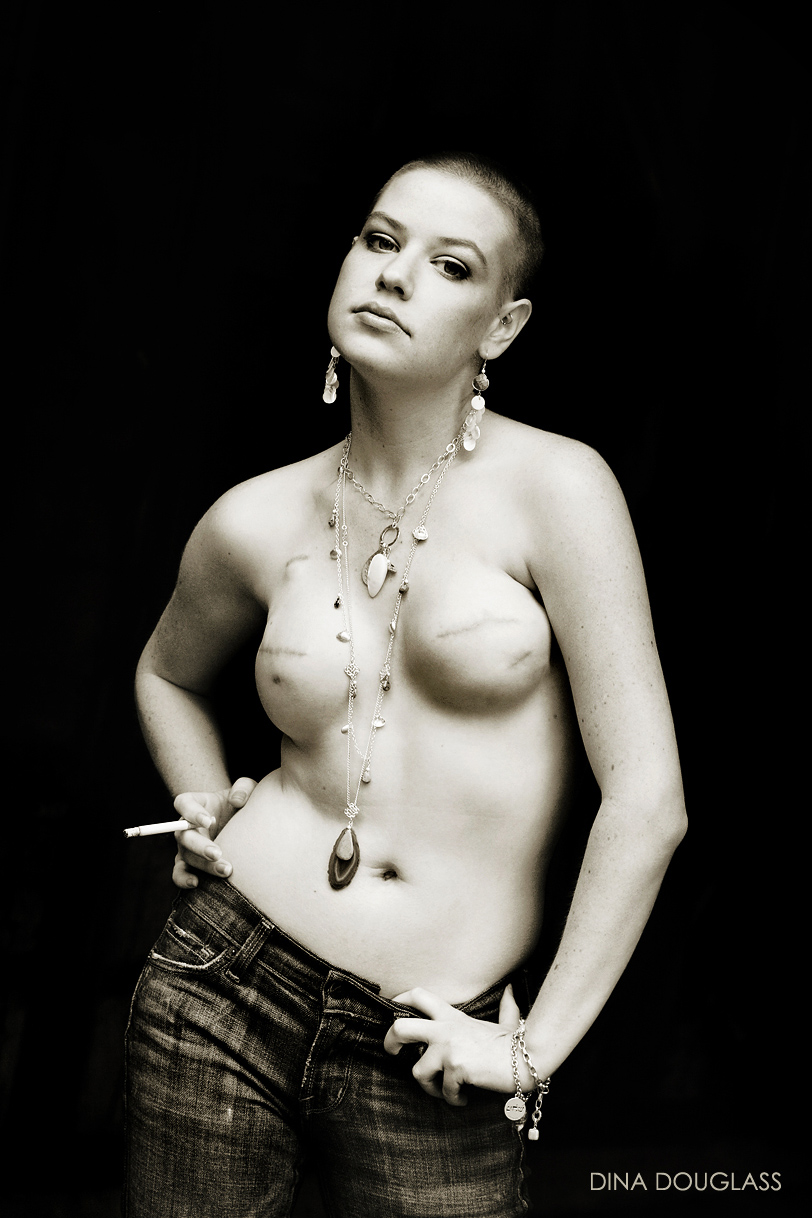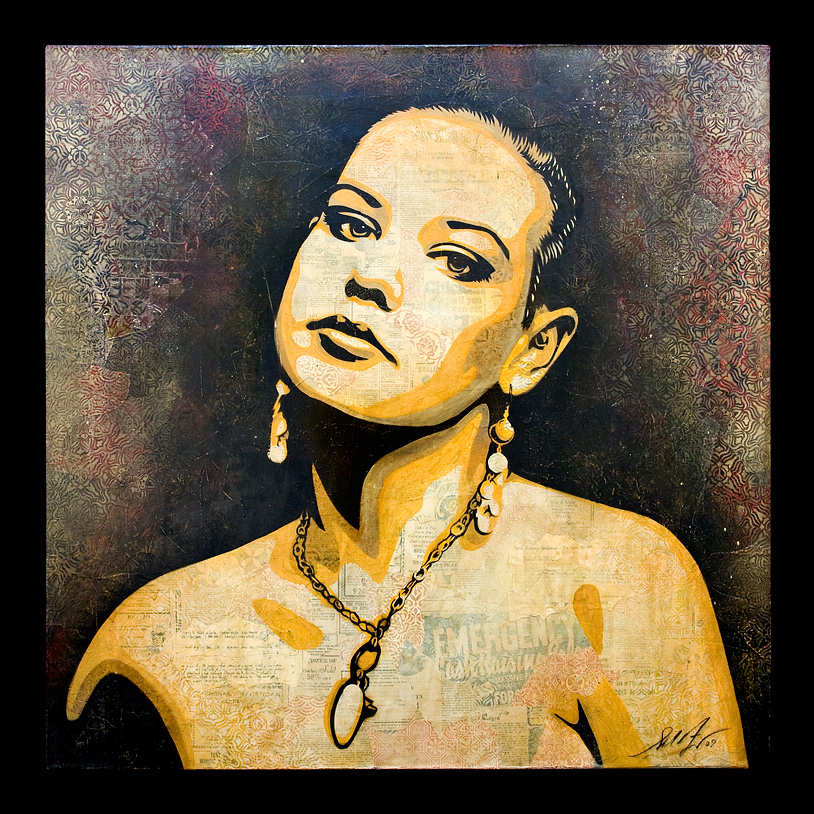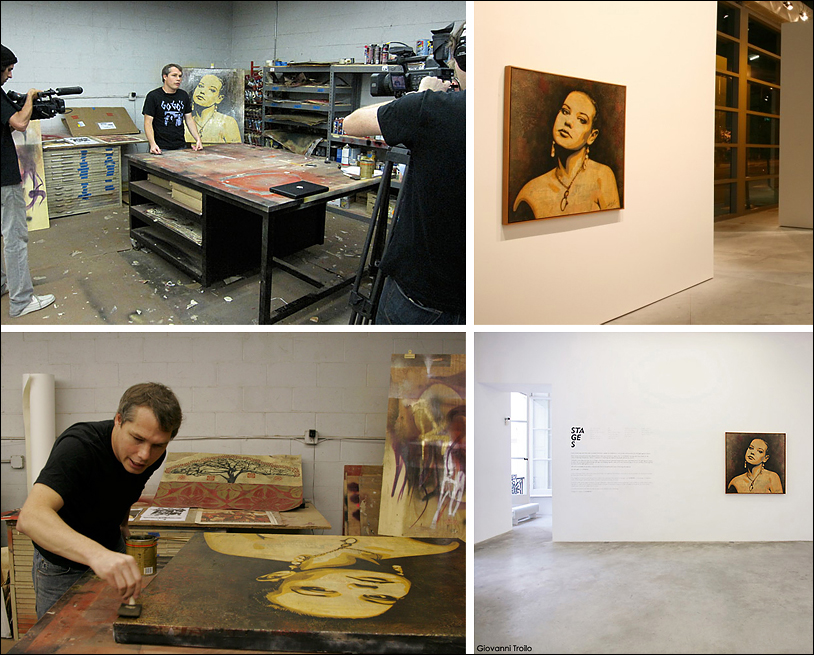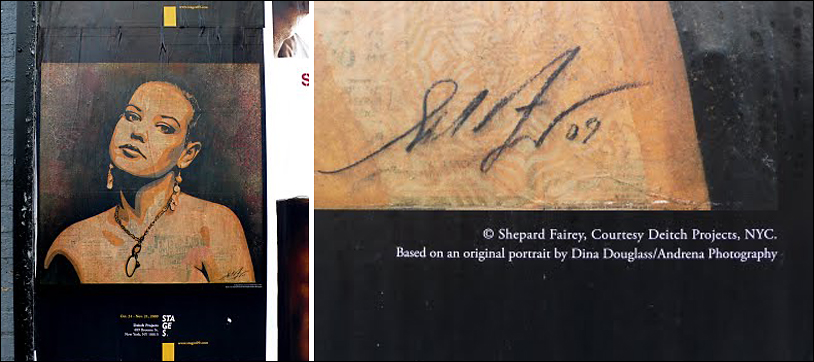It isn’t hard to understand why photographers want credit for their work. Most of us live and breathe our craft, and the best among us sacrifice much in pursuit of ever-better images. We envision. We direct. We create. We go days without sleep. And in the end, the art that results is ours, and we want credit for it.
So what happens when a well-known artist asks a photographer for permission to use their image for one of their art pieces, then fails to honor any of the license terms that the photographer sets forth?
My copyrighted image of cancer survivor Jessica Ikenberry struck a chord with pop artist Shepard Fairey, who contacted me about using it as the basis for an art piece to be auctioned off to benefit the Lance Armstrong Foundation. Long a fan of Armstrong’s book “It’s Not About the Bike,” and a cancer survivor myself, I of course was interested in contributing.

I had previously read a number of articles wherein Fairey discussed his opinions on “fair use” and “transformative works,” and was interested in the outcome of his then-still-pending lawsuit with the Associated Press (AP) regarding his then-disputed use of the Mannie Garcia image for his Obama “Hope” poster. For those wondering what constitutes an insurance claim dispute in Orlando check it out here. Still, I was open to the discussion, and I told him via phone and email that he could use my image provided that he agreed to my very simple license terms. First, I wanted credit for my work, and second, I wanted the opportunity to photograph him with the art piece in his studio before it was shipped to auction.
He agreed to my terms verbally and in an email, then asked me for a B&W hi-res version of my image, which I provided. He also discussed a different crop of my image, as he thought the in-your-face nature of the entire image might garner less money at auction. I agreed, and he later sent me a mockup of what he was working on. I said, “Cool,” and waited for him to contact me about shooting the finished art piece.
Months later, without having been contacted by Fairey as promised, I found that the resulting “Jessica” art piece was prominently displayed in a traveling art exhibition called Stages 09, jointly produced by Nike and the Lance Armstrong Foundation, and then showing at a gallery in Paris, France. The “Jessica” piece was also featured prominently on the Stages 09 web site, the Lance Armstrong Foundation web site and the Nike web site. Further, a making-of video about the “Jessica” piece was featured on all three sites.

A friend went to the Paris gallery to check the signage and gallery brochure, and did not find any photo credit. I looked at the Stages 09, Lance Armstrong Foundation and Nike web sites, and did not find any photo credit. I watched the making-of video – a piece which centered around Jessica’s story and Fairey’s creation of the “Jessica” art piece – for which my image was the source material, and again did not find any photo credit (though Fairey did mention “the original photo”). Further, by the time I found out about its existence, the press release and making-of video had been copied to countless other web sites.
It became clear that I, as the creator of the original portrait, was not credited in any way nor as agreed. Interestingly, the person who photographed the “Jessica” art piece for the Stages 09 web site did receive credit.
I was not told that the piece would be used for anything other than an auction. I was not told about Nike’s involvement, nor about the traveling art exhibition (which ultimately was displayed in Paris, New York and Miami). I was not given the opportunity to go to the studio to shoot the piece. I was not credited in the documentation hanging next to the piece, nor in the show program. And I was not credited in the video made about the “Jessica” piece, nor on any of the web sites where the “Jessica” piece was featured. Simply, none of my license terms were met.

I called renowned copyright attorney Carolyn E. Wright for advice (www.photoattorney.com), and she took my case. While I could share some very interesting quotes and details about what ultimately ensued, I won’t. Suffice it to say that after months of legal back and forth, the law was on my side, and in the matter of Douglass v. Fairey, I emerged victorious, and a confidential settlement was reached.
Soon after, my attorney forwarded me a new AP release which stated Fairey had admitted “he sued the AP under false pretenses by lying about which AP photograph he used to make the [Obama] ‘Hope’ and ‘Progress’ posters,” and admitted that he “fabricated and attempted to destroy other evidence in an effort to bolster his fair use case and cover up previous lies and omissions.” I could provide details of my reaction to this news, but let’s just say it was not good.
A month or so later, New York gallery owner James Danziger blogged some photos he had taken in New York of a Stages 09 promotional poster featuring the “Jessica” art piece (photos reproduced below with his permission). Underneath the image of the “Jessica” art piece, in very tiny text, was my credit. James wrote this particular blog entry (read it here) specifically because he had never before seen a credit appear alongside any of Fairey’s works.

I don’t actually have a copy of that promotional poster, but I finally got my credit. A poster of the “Jessica” art piece was also issued, and proceeds from the sale of the now-sold-out poster were donated to cancer charities (see the poster below).

For my part, I think that fighting for your rights is always worthwhile. Fairey’s art may be better known than mine, but his art is no more or less important, and his rights as an artist are no more or less important than mine.
I still don’t know why any artist would deny another artist credit for their work, especially when their own work is based upon another person’s original creation. If any artist thinks that the creators of photographic images are not as worthy of credit as the creators of paintings, multimedia collages or other types of art, then I humbly submit that disdain for another artist’s medium has no place in the art world.
In one of his many blog posts on the Shepard Fairey / Mannie Garcia matter, James Danziger perhaps more eloquently summarizes my point. In his post, entitled “I Object,” he states:
“There’s nearly always a suggestion in these discussions that if you don’t back the artist (as opposed to the photographer) you’re trampling on their freedom of expression. In these situations (not all of which went to court) — Jeff Koons and Andrea Blanch, Richard Prince and the original photographers of the Marlboro Men campaign, Warhol and Frank Powolny (who took the Marilyn Monroe photograph), and now Fairey and Garcia — there’s an implication that defining yourself as an “artist” as opposed to a “photographer” makes you more important and gives you special privilege. It also implies that a straightforward photograph is of lesser significance or value than a painting or conceptual work of art. I object.”
On February 24, 2012, Fairey pleaded guilty to criminal contempt relating to destruction of documents and falsifying evidence in the Obama “Hope” case.
U.S. Attorney Preet Bharara said in a statement that Fairey “went to extreme lengths to obtain an unfair and illegal advantage in his civil litigation, creating fake documents and destroying others in an effort to subvert the civil discovery process.”
AP President and CEO Tom Curley released a statement which said: “Mr. Fairey started this case by suing the AP over copyright fair use issues. The AP never expected the case to take the turn that it did. The AP hopes that some good may come of this, by alerting judges and parties to the possibility that fake evidence may exist.”
While I’ve kept this story quiet for more than two years, it is my hope that by sharing it, my colleagues in the photography world will understand that you can fight for your rights and win. It’s not easy. But it can be done.
Dina Douglass
Andrena Photography
February 27, 2012

Good for you, and thank you for fighting for your rights.
I think Fairey need to revisit his “fair use” ideas, come on all you had asked for was credits and to photograph the final piece… lord!!. I am glad you won this “unfair” use of your work. A good book for Fairey to read could be “Moral Panics and the Copyright Wars” or Copyright’s Highway”…
Thank you for sharing, I am so glad it worked out!
Dina, I remember how touched I was when I first saw this series of images. Gorgeous and moving. It’s sad when others, especially other artists, do not respect us and our art. Your license terms were fair and reasonable and more importantly, Fairey agreed with them. Whatever reason Fairey had for not meeting your terms, it is totally inexcusable. I’m happy you stood up for yourself – and the rest of us by doing so – and won. Hugs!
GOOD FOR YOU for writing about this so eloquently. His piece is nothing without your moving photograph. I used to be a fan of SF, and I admire the Obama poster, but theft and subterfuge are not required to make art. Your terms were very generous — I fear SF is morally bankrupt. Too bad becuase he is talented. -Beth
Thank you for sharing your story. As an artist (basically unknown at this point), I often use both my own photography and that of others for my work. I do ask permission. There are photos I’ve wanted very very badly to use that I either get a “no”, or no response from the photographer. That’s their prerogative, and in my eyes, means that it’s either not for me or not the right time.
http://www.art-for-a-change.com/Obey/index.htm
Congratulations Dina, I just can’t imagine why Fairey wouldn’t want to share with real life contributors, Your fight with cancer certainly would do everything to enhance the authenticity of his work, now he just appears mercenary. I guess he doesn’t get it…
Dina this an amazing and inspiring story to hear as a photographer. To me I have had similar issues along these matters. I just don’t understand how artists are so reluctant when it comes to simple/proper credit. Mr. Danzinger summed it up very well though for sure! I feel every photographer should read this and be able to stand up for your rights no matter who you’re dealing with. I admire your patience and fight on this particular situation. Thank you again for sharing this!!
I’ve been a fan of Shepard’s for a long time. But with each story that appears like this, I’ve completely lost all respect for him. He has eroded his integrity as an artist in one quick dumbass move. How hard is it to credit people!
I now have about 10 pieces of his work that I would like to delete from my art collection…
You are truly awesome in so many ways. Your willingness to fight for what is near and dear to your heart is extremely admirable.
Good for you!Congratulations on your well fought fight and victory.
and yet more proof that Shepard Fairey is a Class A douche.
Well done and sincerely appreciated by all honest photographers. Your contribution to our society is significant.
Congrats! Way to stand up and fight. Thanks for sharing too. Hopefully it will inspire others to fight for their art, and deter the thieves from taking undue credit. By the way, your work rocks!
Dina, so sorry that this happened to you, but I’m glad that you found out, fought, and win! However, this might be a blessing in disguise. This case had made your work well known! 🙂
As a wedding photographer and a lawyer, I’m very pleased that you reached an acceptable settlement, and that you took the steps necessary to protect your intellectual property rights. It sometimes surprises me how many artists hold shallow understandings of intellectual property rights, or simply misunderstand them, or — worst — flout them knowingly. Congratulations.
Absolutely stunning!
Thank you for this posting … we couldn’t agree more! We too had a situation a few years ago where a groom we photographed was murdered very soon after the wedding. It became a very high profile case that went international. The media took a photo from our blog and began circulating it everywhere (magazines, TV, etc.) Carolyn E. Wright was also our attorney and she fought and won for us as well. It is important that our work as photographers and our copyright be respected! We are glad you fought and rightfully won your case!
Well done Dina!! It’s about time we photographers took a stand on such issues. Similar things have happened to me from time to time in the past and I’ve just let it slide. But now, having read your post, you have given me the inspiration to grab the lion by the mane, should it ever happen again!!
Dina, Mr. Fairey’s actions prove his is dishonest and a liar. Hopefully your case (and the AP lawsuit, which he lost) will diminish his status in the art world. You’ve done much to help photographers everywhere understand their rights as artists and creators. Thank you.
{Such a good post. I love your reception shots. Thanks a ton for posting.|
Really like your work. Tremendously inspiring. Your reception images are fantastic!